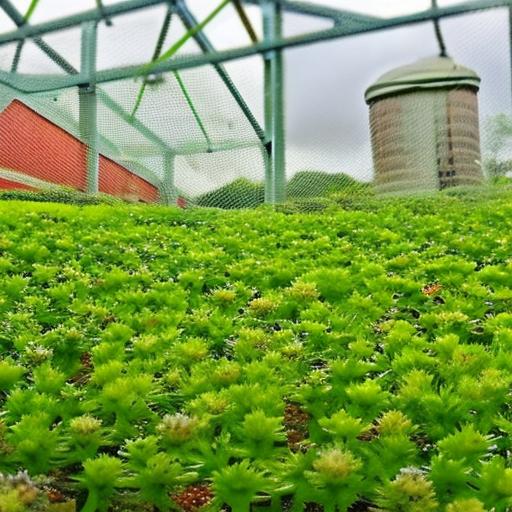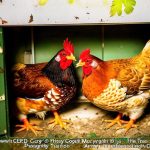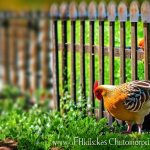Green roofs are becoming increasingly popular in urban areas as a way to combat the negative effects of urbanization. These roofs are covered in vegetation, providing numerous benefits such as reducing the urban heat island effect, improving air quality, and increasing biodiversity. On the other hand, chicken keeping has also gained popularity in recent years as people become more interested in sustainable food production and self-sufficiency. Combining these two practices by keeping chickens on green roofs can be a great idea, as it maximizes the benefits of both.
Key Takeaways
- Green roofs can be used for both gardening and keeping chickens.
- Keeping chickens on green roofs can provide benefits such as pest control and fertilizer production.
- Factors such as weight limits, access, and climate must be considered before keeping chickens on a green roof.
- A chicken coop on a green roof should be designed to be lightweight, secure, and easy to maintain.
- Breeds such as bantams and silkies are well-suited for green roofs, and chickens should be fed a balanced diet and provided with adequate water and shelter.
Benefits of keeping chickens on green roofs
One of the main benefits of keeping chickens on green roofs is the reduction of the urban heat island effect. Green roofs absorb and retain heat, reducing the amount of heat that is radiated back into the atmosphere. By adding chickens to the mix, their body heat can further contribute to this heat absorption, helping to cool down urban areas.
Another benefit is improved air quality. Green roofs act as natural air filters, removing pollutants and particulate matter from the air. Chickens also contribute to this by producing manure, which can be composted and used as fertilizer for the vegetation on the roof. This natural fertilization process helps to improve soil quality and promote healthy plant growth.
Keeping chickens on green roofs also increases biodiversity in urban areas. The vegetation on green roofs attracts insects and other small animals, providing a food source for chickens. In turn, chickens help control pests such as insects and rodents, creating a balanced ecosystem on the roof.
Lastly, combining green roofs with chicken keeping allows for sustainable food production. Chickens can provide a source of fresh eggs and meat for urban dwellers, reducing their reliance on industrial agriculture and supporting local food systems.
Factors to consider before keeping chickens on green roofs
Before embarking on the journey of keeping chickens on a green roof, there are several factors that need to be considered. First and foremost, it is important to check building codes and regulations in your area. Some cities may have restrictions on keeping livestock, including chickens, on rooftops. It is essential to ensure that you are in compliance with these regulations before proceeding.
The structural capacity of the roof is another important factor to consider. Green roofs can be heavy, especially when they are wet, and adding the weight of chickens and their coop can further strain the structure. It is crucial to consult with a structural engineer to assess the load-bearing capacity of the roof and make any necessary reinforcements.
Accessibility for maintenance is also a key consideration. Green roofs require regular maintenance, such as watering, weeding, and pruning. It is important to ensure that there is safe and easy access to the roof for these tasks. Additionally, consider how you will transport supplies and equipment up to the roof, as this can be challenging in some cases.
Lastly, it is important to consider your neighbors and potential noise issues. Chickens can be noisy, especially when they are laying eggs or feeling threatened. Before keeping chickens on a green roof, it is important to discuss your plans with your neighbors and address any concerns they may have. Open communication and cooperation can help create a harmonious living environment for everyone involved.
Designing and constructing a chicken coop on a green roof
When designing and constructing a chicken coop on a green roof, it is important to choose the right materials that are lightweight yet durable. Opt for materials such as lightweight metal or plastic for the structure of the coop, as they will not add unnecessary weight to the roof. Additionally, consider using recycled or sustainable materials whenever possible to minimize environmental impact.
The size and layout of the coop should be designed with both the chickens’ needs and the green roof’s requirements in mind. Provide enough space for the chickens to move around comfortably and include nesting boxes for them to lay eggs. Additionally, consider incorporating a run or outdoor space for the chickens to roam and forage.
Incorporating greenery into the design of the coop can help blend it seamlessly with the surrounding vegetation on the green roof. Consider adding planter boxes or trellises for climbing plants to create a visually appealing and cohesive look. This integration of greenery can also provide additional shade and shelter for the chickens.
Choosing the right breed of chickens for a green roof
When choosing the right breed of chickens for a green roof, there are several considerations to keep in mind. First and foremost, consider the climate and environment in which you live. Some breeds are better suited to cold climates, while others thrive in warmer climates. Choose a breed that is well-adapted to your specific climate to ensure the health and well-being of your chickens.
Egg production and temperament are also important factors to consider. If you are primarily interested in egg production, choose a breed known for its high egg-laying capabilities. On the other hand, if you are looking for chickens that are docile and friendly, choose a breed with a calm temperament.
Size and weight are also important considerations, especially when keeping chickens on a green roof. Opt for smaller or medium-sized breeds that are lighter in weight to minimize the strain on the roof structure. Large and heavy breeds may not be suitable for rooftop chicken keeping.
Feeding and caring for chickens on a green roof

Feeding and caring for chickens on a green roof is similar to caring for chickens in any other setting. Provide a balanced diet that includes a mix of commercial chicken feed, fresh fruits and vegetables, and access to insects and vegetation on the roof. It is important to ensure that the chickens have access to clean water at all times to stay hydrated.
Regular health and wellness checks are essential to ensure the well-being of your chickens. Monitor their behavior, appetite, and overall appearance for any signs of illness or distress. Additionally, provide regular veterinary care, including vaccinations and deworming, to prevent and treat any potential health issues.
Managing waste and maintaining cleanliness on a green roof
Managing waste and maintaining cleanliness on a green roof is crucial to prevent odors, pests, and disease. Composting chicken manure is an effective way to manage waste and create nutrient-rich fertilizer for the vegetation on the roof. Use a designated composting area or bin to collect the manure and regularly turn it to promote decomposition.
Regular cleaning and maintenance of the chicken coop is also important to maintain cleanliness. Remove any soiled bedding, feathers, or debris from the coop on a regular basis. Additionally, regularly clean and disinfect the coop to prevent the buildup of bacteria and parasites.
Pest control is another important aspect of maintaining cleanliness on a green roof. Implement measures such as installing wire mesh around the coop to prevent rodents and other pests from entering. Additionally, consider using natural pest control methods such as planting herbs or flowers that repel insects.
Dealing with potential predators and pests on a green roof
When keeping chickens on a green roof, it is important to be aware of potential predators and pests that may pose a threat to your chickens. Common predators include raccoons, foxes, hawks, and rats. Implement preventative measures such as installing secure fencing or netting around the coop to keep predators out.
In addition to predators, pests such as mites, lice, and worms can also be a concern. Regularly inspect your chickens for signs of infestation, such as itching or feather loss. Treat any infestations promptly using appropriate methods such as dusting with diatomaceous earth or using natural pest control products.
If you do encounter a predator or pest issue on your green roof, it is important to address it in a safe and humane manner. Avoid using harmful chemicals or methods that may harm the environment or other animals. Instead, consider using deterrents such as motion-activated lights or sound devices to scare away predators.
Legal considerations for keeping chickens on a green roof
Before keeping chickens on a green roof, it is important to be aware of the legal considerations and requirements in your area. Zoning laws and regulations vary from city to city, and some may have restrictions on keeping livestock, including chickens, in urban areas. Research the local regulations and ensure that you are in compliance before proceeding.
In addition to zoning laws, there may be permitting and licensing requirements for keeping chickens on a green roof. Some cities require permits or licenses for keeping livestock, and it is important to obtain these before starting your chicken-keeping venture. Failure to comply with these requirements can result in fines or other legal consequences.
Liability and insurance are also important considerations when keeping chickens on a green roof. Consult with your insurance provider to ensure that you have adequate coverage for any potential accidents or injuries that may occur. Additionally, consider liability issues and take appropriate measures to prevent any harm to others or their property.
Is keeping chickens on a green roof feasible and sustainable?
In conclusion, keeping chickens on a green roof can be a feasible and sustainable practice with numerous benefits. The combination of green roofs and chicken keeping can help reduce the urban heat island effect, improve air quality, increase biodiversity, and promote sustainable food production. However, there are several factors to consider before embarking on this endeavor, including building codes and regulations, structural capacity of the roof, accessibility for maintenance, and potential noise concerns from neighbors.
Designing and constructing a chicken coop on a green roof requires careful consideration of materials, size, layout, and integration of greenery. Choosing the right breed of chickens is also important, taking into account climate and environment, egg production and temperament, as well as size and weight. Feeding and caring for chickens on a green roof is similar to caring for chickens in any other setting, with a balanced diet, regular health checks, and access to clean water.
Managing waste and maintaining cleanliness on a green roof involves composting chicken manure, regular cleaning and maintenance of the coop, and implementing pest control measures. Dealing with potential predators and pests requires preventative measures and safe removal methods. Legal considerations include zoning laws and regulations, permitting and licensing requirements, as well as liability and insurance.
In conclusion, keeping chickens on a green roof can be a rewarding and sustainable practice that maximizes the benefits of both green roofs and chicken keeping. By carefully considering the various factors and taking appropriate measures, it is possible to create a harmonious and productive environment that benefits both humans and the environment.
If you’re interested in the idea of keeping chickens on a green roof, you may also want to check out this informative article on turning a shed into a chicken coop. It provides valuable insights and practical tips on how to create a suitable and comfortable living space for your feathered friends. Whether you’re a beginner or an experienced chicken keeper, this article from Poultry Wizard is a great resource to help you get started. Read more here.
FAQs
What is a green roof?
A green roof is a roof that is partially or completely covered with vegetation and a growing medium, planted over a waterproofing membrane.
Can you keep chickens on a green roof?
Yes, you can keep chickens on a green roof, but it requires careful planning and consideration of the weight load, access, and safety of the chickens.
What are the benefits of keeping chickens on a green roof?
Keeping chickens on a green roof can provide several benefits, including reducing the urban heat island effect, improving air quality, reducing stormwater runoff, and providing fresh eggs and meat.
What are the challenges of keeping chickens on a green roof?
The challenges of keeping chickens on a green roof include ensuring the roof can support the weight of the chickens and their coop, providing access to the roof for the chickens and their caretakers, and protecting the chickens from predators.
What are some considerations for building a chicken coop on a green roof?
When building a chicken coop on a green roof, it is important to consider the weight load, drainage, and waterproofing of the roof, as well as providing adequate ventilation, insulation, and protection from predators.
What types of chickens are best suited for living on a green roof?
Chickens that are best suited for living on a green roof are those that are small, lightweight, and able to fly short distances, such as bantam breeds. It is also important to choose breeds that are adaptable to different climates and able to tolerate the conditions of a rooftop environment.
Meet Walter, the feathered-friend fanatic of Florida! Nestled in the sunshine state, Walter struts through life with his feathered companions, clucking his way to happiness. With a coop that’s fancier than a five-star hotel, he’s the Don Juan of the chicken world. When he’s not teaching his hens to do the cha-cha, you’ll find him in a heated debate with his prized rooster, Sir Clucks-a-Lot. Walter’s poultry passion is no yolk; he’s the sunny-side-up guy you never knew you needed in your flock of friends!







